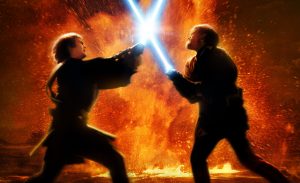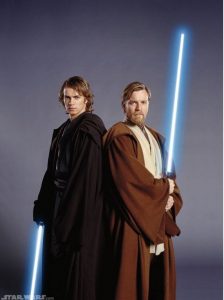“A long time ago in a galaxy far, far away…”
Star Wars: Episode III – Revenge of the Sith brings Fantasy/Sci-Fi to life as George Lucas directs another classic. This blockbuster film released in 2005 perfectly illustrates George Lucas’ cinematic language in ways that we can only sit and watch in awe. Revenge of the Sith puts together a complex plot onto a framework of virtually non-stop action. Although much of the audience already knows what is supposed to happen in the movie, Lucas once again amazes and surprises. The first 20 minutes — a breathtaking rollercoaster of explosions and acrobatics, space battles, lightsaber duels — rivals anything we’ve seen in the series.
The film begins with action and chaos and continues that theme throughout the entirety of the movie. Lucas re-introduces us to two of the protagonists immediately and emphasizes their relationship. Throughout the movie, although at times the dialogue is vague and sometimes cheesy, we see the connections and relationships between many different characters. Many say that the whole movie is about the relationships between Anakin Skywalker (Hayden Christensen), Padme (Natalie Portman), and Obi-Wan (Ewan McGregor). These relationships are altered, flipped, re-born, and destroyed in the movie. Revenge of the Sith doesn’t waste time on useless characters or plod through the usual Senate meetings or interstellar politics.
A technique or characteristic that George Lucas is known for and uses in all his films, is music. Lucas uses an array of gorgeous music, spanning from the ‘force theme’, to the ‘imperial march’, to ‘binary sunset’, to the classic ‘Star Wars’ theme composed by John Williams. These songs and themes are perfectly placed throughout the film to create a tone in the scene. For example, in the end of the movie when Darth Vader is being propped up on the table, Lucas chose to put ‘Enter Lord Vader’ by the London Symphony Orchestra, composed by John Williams, a song that builds anticipation like no other, perfect for this scene. Another example would be when Mace Windu and the Sith Lord duel. During this scene, we hear a song called ‘unlimited power’, again by the London Symphony Orchestra, and again composed by John Williams. We sense the tone through the music, as the trumpets get louder and create anxiety throughout the duel.
Lucas uses vast landscapes and high tech props to portray his beautiful mise-en-scène throughout the whole movie. The scene that shows his style the most though, is the battle scene between Anakin Skywalker (Hayden Christensen) and Obi-Wan (Ewan McGregor). We are brought to Mustafar, and immediately given the feeling that this place is a source of evil. The design of the environment on Mustafar lets the audience know that something big is going to happen here, and it does. The epic duel between Obi-Wan and Anakin leads them through a massive stronghold. The arrangement of scenery and stage properties in this scene (mise-en-scène) are amazing. Lucas purposely shows Anakin slash a computer console with his lightsaber, resulting in the deactivation of the building’s shields. He purposely makes the audience see this so that they understand why the facility is being bombarded by lava. As Obi-Wan and Anakin continue their epic duel, leaping from one platform to another, Lucas continues to add more and more to the scene. He and John Williams bring in The Great Final Duel: Anakin vs. Obi-Wan, a song that creates just the right amount of anticipation and thrill. The order in which this scene takes place was beautiful, showing Anakin slowly turning to the dark side, building up to this massive duel with Obi-Wan, and then bringing it to a rightful end. Lucas does all of this within a duration of 5 minutes, allowing the audience to not be on the edge of their seats for too long, making this my favorite overall scene in the movie.
Because the material is so passionate in this installment, with so many conflicting emotions and climactic confrontations, Lucas’ storytelling has vastly improved. But what’s odd and relieving about this script, as opposed to the others, is that the dialogue doesn’t tell the story. It’s the visuals and the extensive emotions that pilot Revenge of the Sith. A perfect example of the “vague” dialogue can be found in end battle scene again between Obi-Wan and Anakin. A mere handful of words are spoken between the two Jedi. After a small amount of yelling at each other they engage in battle and the remaining duration is lightsaber fighting.
Another thing that Lucas incorporates into this movie subtly is a good amount of humor. Whenever the audience isn’t watching lightsaber duels or space battles, they’re bound to hear a funny remark from some character, usually it being the main characters. An example of this is when Anakin Skywalker (Hayden Christensen) and Obi-Wan (Ewan McGregor) are speaking with General Grievous (anti-hero). The general makes a remark saying that he thought Anakin would be older, so Anakin makes a funny remark saying that he thought that Grievous would be taller. Little jokes like this are placed in random, but perfect, spots throughout the whole movie to lighten the mood.
But finally, the style that is shown in Star Wars might just be the best part of the film. There is a specific style for each character in the movie. Anakin Skywalker (Hayden Christensen), for example, always wears a brown or black Jedi robe, while Obi-Wan (Ewan McGregor) always wears a tan or brown robe. A character that perfectly portrays Lucas’ crazy sense of style is Padme (Natalie Portman). Ranging from her hair, to her outfits, to her makeup, Padme is by far the most stylish character in the movie. In the ending battle between Anakin and Obi-Wan, Lucas purposely has Anakin wearing a black robe while Obi-Wan wears a light tan robe, symbolizing the dark and light sides, just another detail that was perfectly applied.
George Lucas has achieved what few artists do, he has created and populated a world of his own. Star Wars is one of the most influential, both technically and commercially, series ever made.
Barsam, Richard Meran. Looking at Movies: An Introduction to Film. New York: W.W. Norton, 2007. Print.
Star Wars, Episode III, Revenge of the Sith. By George Lucas. Dir. George Lucas. Prod. George Lucas and Rick McCallum. Perf. Ewan McGregor, Natalie Portman, and Hayden Christensen. 20th Century Fox, 2005.


